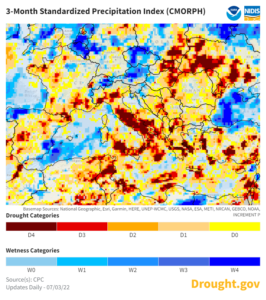
Farmers in Italy are unable to support their crops as the country suffers an epic drought. Already the world is facing fears of food shortages, droughts in places like Italy, the American midwest, parts of Ukraine, central Africa, and swaths of Asia could severely affect the global balance of food production. Eric Sylvers reports on the drought in Italy in The Wall Street Journal:
Italy’s worst drought in decades threatens to ruin many crops and is forcing a reckoning of how the country manages its water resources, as rising average temperatures increase the frequency of extreme weather events across Europe.
The Po, Italy’s longest river and the main water source for some of the country’s most fertile farmlands, is at its lowest level since at least the mid-1940s. Some of the Po’s tributaries are completely dry. The water in Lake Como, a popular tourist destination, is near the lowest level ever recorded for this time of year.
Every month this year, rainfall has been below the average of the last 60 years. In addition, the Po and other rivers have received a low level of snow runoff, the result of a below-average snowfall this past winter in most of the Alps. Soaring heat, which has set records in some Italian cities, has led to more evaporation than usual.
“Temperatures are rising and that means more droughts like we are seeing in Italy,” said Claudio Gandolfi, a professor of agricultural hydraulics at the University of Milan. “We can’t pretend extreme weather events won’t bring crises like this. We must have a clear idea how we’re going to manage them and limit the damage.”
The drought and unseasonably high temperatures over the past several months have also had dramatic consequences in the Italian Alps. On Sunday, a large part of a glacier broke off, triggering a massive avalanche that killed at least seven people. Thirteen people are still missing and presumed dead, according to rescue workers. Years of rising temperatures have caused the glacier to deteriorate and the recent heat gave the final push, said Renato Colucci, a glaciologist at Italy’s National Research Council.
Extreme weather events have also hit other European countries this summer. Some French regions set water restrictions after the hottest May on record and temperatures in June hit highs normally not seen until July and August. Biarritz, a resort on the Atlantic coast near Spain, in June topped 109 degrees Fahrenheit, its highest recorded temperature.
If you’re willing to fight for Main Street America, click here to sign up for the Richardcyoung.com free weekly email.





